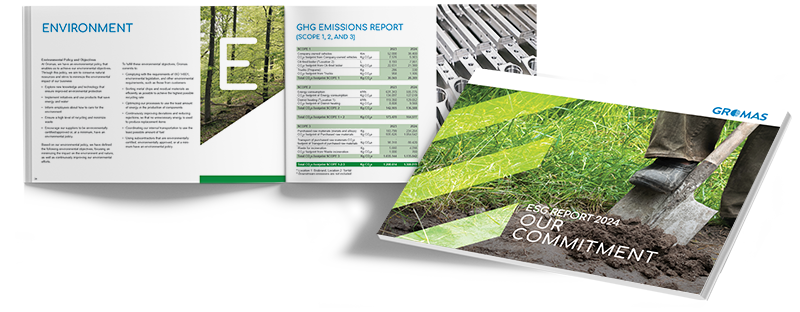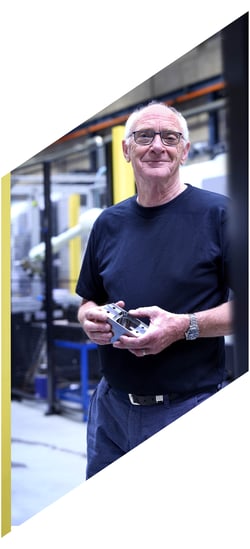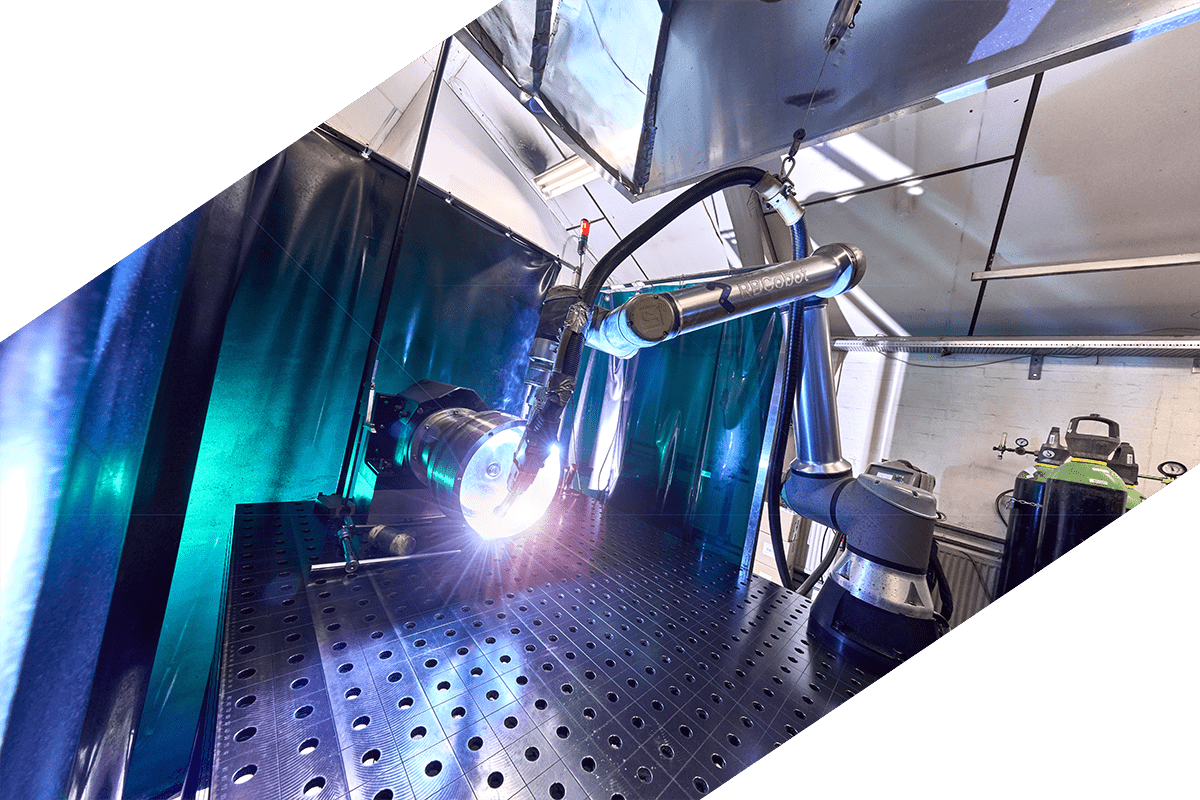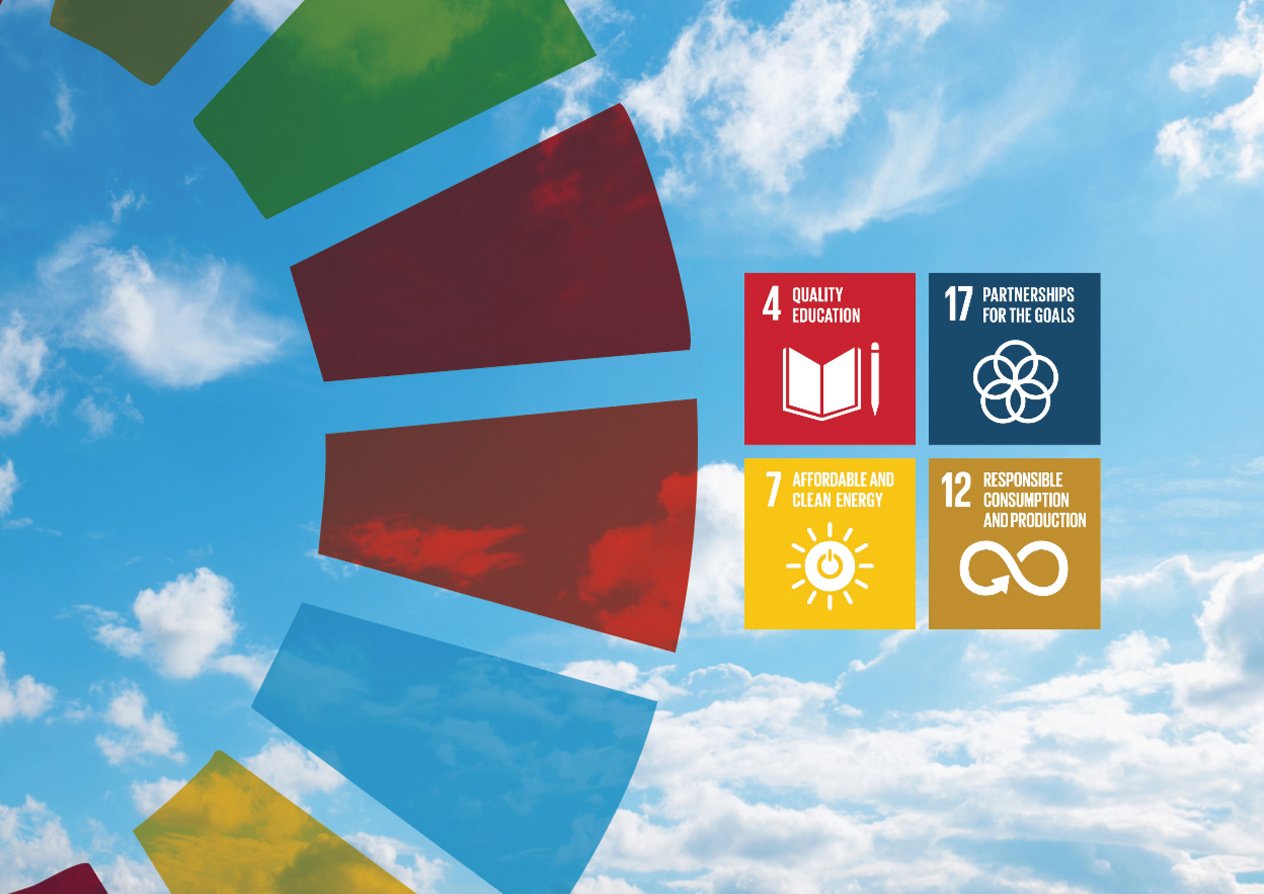ESG Report 2024
Our commitment
General Information
GROMAS MASKINFABRIK A/S is part of a group consisting of two companies. The parent company is GROMAS HOLDING ApS.
The company consists of two production units:
Gromas Maskinfabrik A/S
CVRP No. 1000321718
Located at Spobjergvej 3A, 8220 Brabrand, DK
(Location 1)
Production Torrild
CVRP No. 1018843419
Located at Præsthøjvej 8, 8300 Odder, DK
(Location 2)
NACE Sector Code
255300 – Machining of metal. This code indicates that the company is engaged in the processing and machining of metal products, including welding, CNC machining, assembly, and similar machine manufacturing activities.
Download our ESG report
You can download the report as print friendly pdf in spreads and single page versions.
You can also read the report as animated flipbook.

Dear reader
Søren Agerbæk, CEO
We are proud to present our first ESG report. In this report, we bring together our initiatives and the key data that help us strengthen our work with sustainability. We have taken the first steps, and although the report is not yet fully comprehensive, we believe that the most important thing is to get started.
The report documents our efforts to run a responsible business and supports us in making the right decisions for the future.
Challenges in Unpredictable Times
2024 was a year marked by challenges and global unrest that impacted raw material prices and supply chains, while we also faced rising energy costs and economic uncertainty.
As a metalworking company, we have felt these fluctuations, but we have also recognized the importance of working purposefully with efficiency, resource optimization, and sustainable solutions.

Sustainability in Practice
For us, sustainability is not just about responsibility — it is also an opportunity to create long-term value. We see ESG as a natural part of our business, because we want to take responsibility for our materials, energy consumption, and the well-being of our employees.
We understand that our industry has a role to play in the green transition, and we will continue to seek practical and realistic solutions that benefit both our company and our customers.
We hope this report offers a valuable insight into our efforts, and we look forward to continuing our sustainability journey in the years to come.
Our Efforts in 2024
We are committed to actively contributing to the green transition — both within our own company and across the industry we are part of. We see it as our responsibility to use resources wisely, reduce waste, and find smarter ways of working. ESG has become a natural part of our daily operations, and with this report, we aim to provide a clear picture of what we have already achieved and where we can continue to improve.
Economy and the Future
Despite a challenging year, we have managed to remain financially stable and deliver solid results. As we look ahead to 2025, we maintain a strong ambition to further strengthen our sustainability initiatives and to find solutions that benefit our company, our customers, and the environment alike.
About Gromas
Gromas Maskinfabrik A/S – Your Specialist in Metal Components
Gromas is your reliable partner in the development and production of metal components for the Food, Pharma, Offshore, and Defence industries. With deep technical expertise, strong project management, and comprehensive certifications, we create the ideal conditions for delivering top-quality products.
We have over 40 years of experience working in demanding and corrosive environments and are experts in precision chip-forming machining, welding, and assembly of metal components.
Through close collaboration with our customers, we have developed a solid understanding of the specific requirements and standards of each industry we serve.
Quality at Every Stage
We ensure full traceability of all materials in our production, allowing them to be tracked throughout their entire lifecycle. With our experience in development, design, and product maturation, we maintain a constant focus on optimization to deliver the best possible end product to our customers.
Our quality management system is certified according to ISO 9001, ensuring that we consistently meet our customers’ expectations — in terms of quality, delivery time, and cost.
Gromas is your trusted partner in development and production of metal components for Food-, Pharma, Offshore- and the Defence industry.

Our Most Important Resource – People
Our business is built on professional expertise, close collaboration, and skilled guidance. We know that dialogue is just as important as technical equipment, and that even the most advanced CNC machines cannot deliver results without talented people behind them.
Through trust, transparency, and strong competencies, we develop the best solutions in close partnership with our customers.
We believe that a trust-based collaboration is key to building the strongest partnerships.
Our values are the foundation — and our customers' guarantee — of a rewarding partnership.
We believe in our competencies, stand behind the work we do, and focus on building trust through close dialogue and collaboration. In other words, achieving optimal machine performance requires strong teamwork.
Environment and ESG
At Gromas, we see ourselves as an environmentally conscious company striving to carry out our work with the least possible environmental impact.
We have developed an environmental policy as well as an ESG and sustainability policy that help us meet our environmental objectives. These are focused on minimizing our impact on nature and the environment, while continuously improving our environmental performance.
We are ISO 14001 certified and, of course, comply with environmental legislation and other environmental requirements from, for example, our customers.
We actively participate in the green transition by optimizing our processes, reducing waste, and ensuring more efficient use of resources.
Our ESG report provides insight into our efforts and documents the specific initiatives we implement to minimize our environmental footprint and promote responsible business practices.
IT TAKES COLLABORATION TO MAKE MACHINES PERFORM
How do we work with ESG
At Gromas, we work strategically with ESG as an integrated part of our business and value chain. Our ESG report documents our efforts and helps us build a more sustainable and responsible business – for ourselves, our customers, and the society around us.
VSME – Our Framework for Responsibility and Value Creation
(VSME: Voluntary Standard for Micro, Small and Medium-sized Enterprises)
To ensure a holistic and long-term approach, we use the extended VSME model as the overall framework for our ESG strategy. VSME links our sustainability efforts with business value creation and social responsibility:
- Value Creation
How we as a company create value for customers, employees, partners, and society – through quality, collaboration, and accountability. - Social Responsibility
Our social responsibility – both internally in terms of employee well-being and leadership, and externally through our contributions to society and support for the UN Sustainable Development Goals. - Environment
Our efforts to reduce climate and environmental impacts through energy efficiency, circular practices, responsible transportation, and waste management. - Economy
Our ability to run a healthy, transparent, and resilient business with strong governance, risk management, and compliance.
VSME serves as a holistic framework that ensures our ESG efforts are rooted in both business and societal objectives. It forms the foundation for the initiatives and targets outlined in this report.
Materiality Assessment and Prioritized ESG Areas
To ensure that we focus on the most relevant areas, we have conducted a materiality assessment. This involved analyzing how Gromas impacts the environment, society, and stakeholders – and how the external world impacts us. The assessment was carried out based on the CSRD and the associated ESRS standards, which ensure consistent and comparable reporting across the EU. The assessment was conducted in three stages:
-
Understanding Our Impacts
We have mapped our environmental, social, and governance footprints across the entire value chain and listened to our key stakeholders. - Identification of Focus Areas
We have assessed both positive and negative impacts and analyzed where we can make the greatest difference. -
Prioritization of Key Action Areas
We have identified the following as our most material areas:
- Energy efficiency
- Resource consumption and circular economy
- Employee well-being and development
- Customer relations and behavior
- Governance structure, ethics, transparency, policies, and actions
Reporting Frameworks and Climate Data
Our CO2e accounting follows the GHG Protocol and includes Scope 1, 2, and partially Scope 3.
In this first ESG report, we have chosen to focus specifically on our primary material consumption (metal) and related transportation within Scope 3, as these areas represent the majority of our environmental impact.
We actively engage with ESG and sustainability to manage the most significant risks related to climate, environment, employee conditions, and our value chain. Our management conducts an annual risk assessment, where material risks are translated into concrete action plans.
But sustainability is not only about minimizing risks – it’s also about meeting new expectations from customers and partners. That’s why we view ESG as a strategic opportunity to strengthen our competitiveness and create value through responsibility.
In the following chapters, we present our efforts and results within climate, social responsibility, and good corporate governance – structured according to the ESG framework and guided by the VSME model as the underlying logic.
VSME Overview Model
Highlights from ESG Key Figures
2023 to 2024

Visual Key Figures 2023-2024
ESG and Sustainability Policy
Gromas is committed to integrating sustainability throughout our entire value chain – environmentally, socially, and in governance – in compliance with applicable legislation, international principles, and customer expectations. This policy forms the overall framework for our ESG work and serves as the foundation for specific goals and initiatives, which are reviewed annually.
Environmental
- We continuously measure and reduce our CO₂ emissions in accordance with recognized methods and targets.
- We improve the energy efficiency of our machinery and production lines as part of our climate commitment.
- We choose materials with a focus on resource efficiency and environmental impact.
- We manage waste responsibly and follow the principles of the circular economy.
Social
- We ensure a healthy and safe working environment and promote strong employee well-being.
- We support quality education and ongoing professional development for our employees.
- We promote diversity and inclusion at all levels of the organization.
- We respect human rights and act responsibly toward both customers and society.
Governance
- We have zero tolerance for unethical or illegal business conduct.
- We maintain a clear and transparent governance structure with well-defined lines of responsibility.
- We engage in responsible customer relationships and partnerships that reflect our values.

Double Materiality Assessment
We have conducted the Double Materiality Assessment in accordance with the requirements of the ESRS. This means we have evaluated both:
- Financial Materiality (X-axis)
How sustainability matters affect Gromas’ business. - Impact Materiality (Y-axis)
How Gromas impacts society and the environment.
The topics have been assessed by their degree of materiality using the following scale: Low, Medium, High, Critical.
Based on the Double Materiality Assessment, Gromas has identified a number of significant ESG-related risks and opportunities. These form the basis for our prioritized focus areas and the action plan aimed at strengthening our sustainable development going forward.
In the sections sections, we have chosen primarily to address the focus areas rated as High and Critical.
|
Key Risks |
Negative Impact |
Management/Opportunities |
Action Plan |
|
|
|
|
|
|
|
|
|
|
|
|
|
|
|
|
Key Risks |
Negative Impact |
Management/Opportunities |
Action Plan |
|
|
|
|
|
|
|
|
|
|
|
Key Risks |
Negative Impact |
Management/Opportunities |
Action Plan |
|
|
|
|
|

SDG #7
Affordable and Clean Energy
Through energy-saving initiatives, we strive to minimize and manage our energy consumption in both our facilities and production.
Whenever possible, Gromas recycles surplus heat generated from our production systems to improve and increase overall energy efficiency.
We contribute to CO₂ reduction by participating in NRGi Scanenergi’s climate initiative VINDenergi, which ensures we use 100% renewable and CO₂-neutral energy from Danish wind turbines. We also support global CO₂ reduction through the KLIMAskov initiative, which helps combat the loss of biodiversity.
- Goal 7.2: Increase the share of renewable energy in the global energy mix
- Goal 7.3: Double the global rate of improvement in energy efficiency
SDG #12
Responsible Consumption and Production
We sort all scrap materials, such as metal chips, so they can be sold to scrap dealers and recycled for new production at metalworks.
Gromas invests in the collection and repurposing of waste oil for beneficial reuse. We sort waste in accordance with legislation and continuously aim to reduce waste in both our production and administration.
Whenever possible, we prioritize purchasing European stainless steel, which is primarily based on remelted scrap metal. Steel from our largest supplier is made from 95% recycled material.
- Goal 12.2: Achieve the sustainable management and efficient use of natural resources
- Goal 12.5: Substantially reduce waste generation through prevention, reduction, recycling, and reuse
SDG #4
Quality Education
Gromas trains new apprentices each year, ensuring they leave with valuable experience and a solid education. Our contribution helps raise the national level of competence within metal machining.
We do not differentiate based on demographic factors when welcoming new employees. We believe that the willingness to learn is the fuel for development.
We collaborate with Aarhus Tech, engaging in mutual dialogue about industry needs and future development.
- Goal 4.3: Ensure equal access to technical and vocational education
- Goal 4.4: Increase the number of youth and adults with relevant skills
SDG #17
Partnerships for the Goals
We engage in responsible and transparent partnerships to develop more sustainable solutions.
Our collaboration with suppliers focuses on creating sustainable supply chains, while our customer partnerships promote more environmentally friendly and sustainable choices.
Through a global partnership with EcoVadis, we report our ESG performance and make it visible.
With environmental management certified under ISO 14001, we are able to assess environmental risks and ensure ongoing improvements and reduced environmental impact.
By publishing our GHG Emissions Report, we also provide greater transparency to our partners.
- Goal 17.17: Encourage effective partnerships between public, private, and civil society actors
|
Environmental Policy and Environmental ObjectivesAt Gromas, we have an environmental policy that enables us to achieve our environmental objectives. Through this policy, we aim to:
Based on our environmental policy, we have defined the following environmental objectives, focusing on minimizing the impact on the environment and nature, as well as continuously improving our environmental efforts. To fulfill these environmental objectives, Gromas commits to:
GHG Emissions Report
|
|
Forward-Looking Focus Scope 1 and 2 emissions are developing in the right direction. Going forward, efforts related to Scope 3 must be intensified, as the value chain accounts for the majority of the climate footprint. This involves:
The goal is to strengthen transparency in our environmental efforts and ensure that environmental considerations are integrated even earlier in decision-making processes — from procurement and design to production and logistics. |
*Metal chips sent for recycling are not included in the diagram.
|
Working EnvironmentGromas continuously works to optimize processes and collaboration to ensure minimal environmental impact and the best possible working environment. A Workplace Health and Safety Organization (AMO) has been established, consisting of a representative from executive management, the daily production manager, and two employee-elected safety representatives — one from production and one from administration. Gromas views safety as a shared responsibility and generally does not accept excuses for accidents of any kind. We are committed to continuously minimizing the risk of accidents.
Occupational Health and Safety PolicyGromas is committed to continuously improving the company’s working environment with the aim to:
Social data People and Society EffortsIn 2024, Gromas continued its focus on employee well-being, workplace safety, and social responsibility. Key indicators show a generally stable workforce structure, with a few areas requiring attention. Employee Well-being and Development However, employee turnover increased from 4.88% to 9.41%, suggesting a higher level of staff changes that warrants further analysis. Sick leave decreased from 4.59% to 4.36%, indicating a general improvement in employee well-being and health. Diversity and Inclusion Quality Education We offer apprentices a structured and hands-on training program, with a strong focus on both professional development and well-being. Our employees serve as mentors and help provide young people with a solid foundation for their working life. In addition, we prioritize the continued professional development of all our employees, with a clear ambition to increase participation in relevant courses and continuing education. This approach strengthens both the individual and the overall competence level of the company. Although we have not yet collected specific data in this area, we aim to increase documentation and transparency in the coming years — for example, by reporting on the number of apprentices, collaborative projects, apprentice satisfaction, and employee skills development.
|
|
|
|
Forward-Looking Focus As part of the development of our ESG strategy and governance efforts, in 2025 we are working on the preparation and implementation of the following policies:
In addition, a whistleblower scheme will be introduced to support a culture of openness, integrity, and the ability to report concerns in a safe and structured way. Management will carry out a systematic review of the company’s governance principles, including:
The goal is to ensure that all levels of management and employees have clear behavioral guidelines, and that Gromas' governance structure supports the company’s sustainability and business objectives. |
Final Remarks on our Report
With this first ESG report, Gromas Maskinfabrik A/S has established a solid foundation for future sustainable and responsible operations. The report documents an ambitious and focused effort, where environmental, social, and governance factors are fully integrated into the business.
We recognize that ESG work is a continuous journey. The data and initiatives presented represent a step along the way, and we will continuously evaluate, improve, and evolve our approach. In the coming years, we will intensify our focus on Scope 3 emissions, responsible supplier management, and documentation of our social efforts.
Our ambition is not merely to meet requirements – but to create real value through responsibility, transparency, and collaboration. Gromas views ESG as a strategic opportunity, and we are committed to driving change – for the benefit of the environment, people, and the business.
Appendix and Methodology
Methods, Definitions, and Data Overview
This report has been prepared based on recognized standards for sustainability reporting and is built on both qualitative and quantitative methods. The purpose is to provide a true and fair view of Gromas Maskinfabrik A/S's environmental, social, and governance responsibilities for the fiscal year 2024.
The reporting is based on:
- GHG Protocol (Greenhouse Gas Protocol): The international standard for calculating greenhouse gas emissions has been used to structure data in Scope 1, 2, and parts of Scope 3.
- ESRS (European Sustainability Reporting Standards): Used as a framework for materiality assessment and structural alignment with upcoming EU requirements.
- VSME model (Value, Social, Environmental, Economy): Applied as a structuring principle for ESG efforts, ensuring a holistic approach where value creation is linked to social, environmental, and economic factors.
In addition, the ESG analysis in this report is based on:
- Double materiality assessment, evaluating both impact materiality and financial materiality
- Internal mapping of processes, energy consumption, waste, water use, supplier data, and employee conditions
- Stakeholder input, primarily from management and internal subject matter experts
Data Sources
The quantitative data in this report has been collected from the following sources:
- Energy consumption and emissions: Operational data, electricity bills, and data from NRGi Scanenergi
- Material consumption: Production systems, procurement data, and data from subcontractors
- Waste: Waste statistics from external waste management operators
- Water consumption: Operational data and data from water suppliers
- HR and social indicators: HR systems, employee registers, and occupational health and safety reports
- Financial data: Accounting systems and management reports
- Policies and certifications: Management Handbook as well as documentation for ISO 9001 and ISO 14001
Where possible, the data used has been validated internally and cross-checked with external sources.
Emission Factors (CO₂ Calculations)
- Electricity and district heating: Emission factors from NRGi Scanenergi, based on the Danish electricity and heat mix
- Oil-fired heating systems and propane gas: National emission factors from the Danish Energy Agency (latest available)
- Metals and raw materials (Scope 3): Supplier data and industry averages from the Ecoinvent and Climatiq databases
- Transport: Estimates based on kilometers traveled and factors from the GHG Protocol Transport Tool
- Waste: Emission factors from the Danish Environmental Protection Agency and Klimakompasset (by waste category)
Limitations and Assumptions
- The report covers the fiscal year (2023) and 2024 and includes both locations: Brabrand and Torrild.
- Scope 3 includes only the most material indirect emissions (metal procurement and related transport) and does NOT include downstream emissions.
- Other Scope 3 categories (e.g., business travel, employee commuting, equipment, and subcontractor-related emissions) have not yet been quantified but are under ongoing assessment for potential future inclusion.
- Social aspects such as diversity and apprenticeship initiatives contain partially qualitative evaluations and are under further development.
- The materiality assessment was carried out as an internal process, based on ESRS principles and management’s evaluation of the company’s most significant impacts and risks.
- The volume of metal chips sent for recycling has not yet been quantified, but all chips from production are collected and recycled through external partners.




